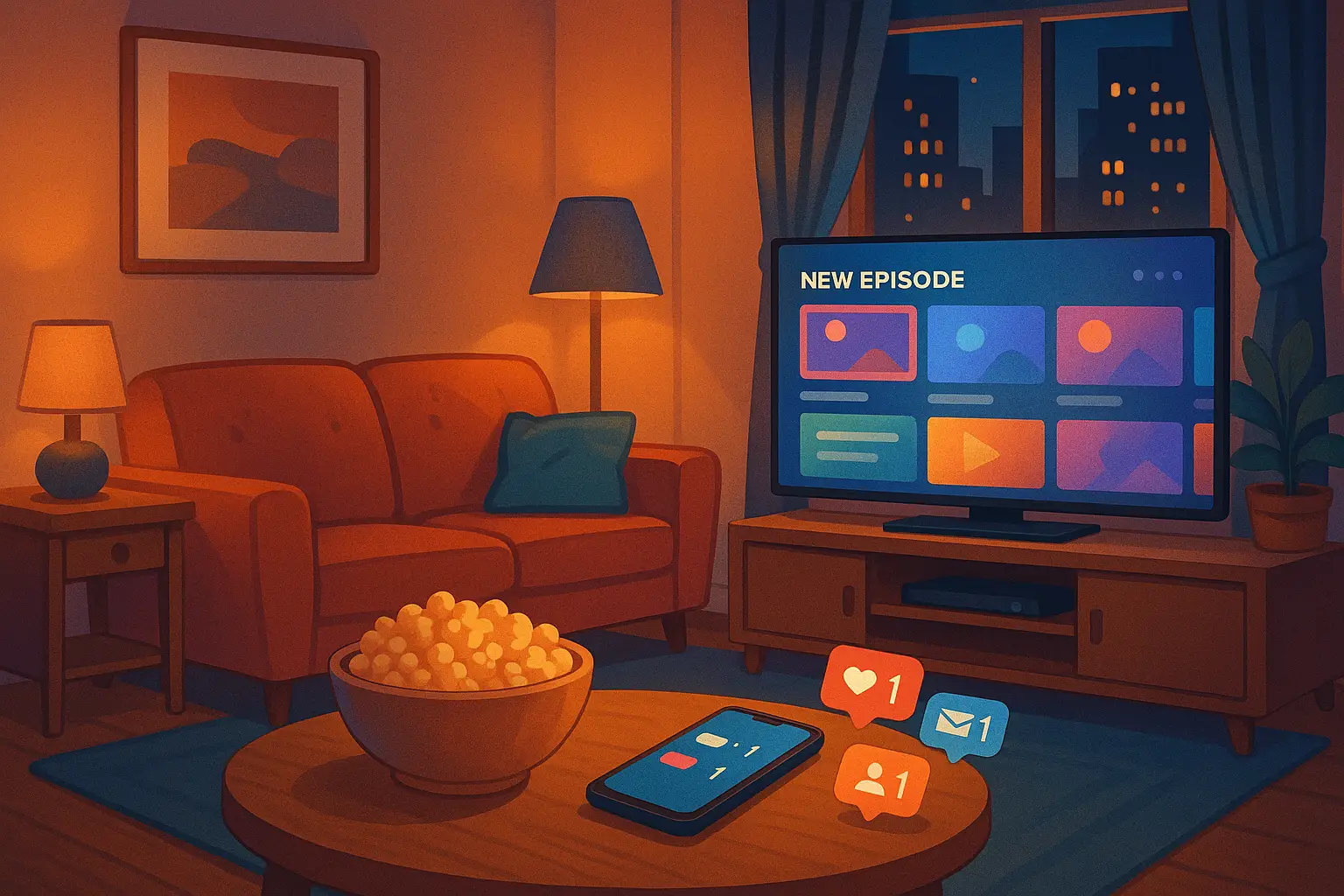Remember the thrill of “just one more episode,” until suddenly the sun rose and Netflix scolded you for still watching? Well, if you’ve noticed lately that your favorite streamer is drip-feeding instead of dumping, you’re not alone. Get comfy. Break out a snack. The TV industry is spinning that carousel back around — weekly episodes are rolling again, and full-season drops are quietly vanishing like a bad reboot.
Binge-Era Glory Days: A Retrospective Snack Break
Way back in 2013, Netflix made bingeing respectable. “House of Cards” hit all at once, and suddenly, sick days multiplied across the globe. Reed Hastings even bragged about the “binge edge” in 2017. Before you could say “Next episode?,” everyone — from Amazon to Hulu — jumped into the binge pool headfirst.
Between 2016 and 2019, the binge model was king. In 2019 alone, Netflix released 159 new seasons — all but eleven dumped at once. And then, 2020 arrived, with lockdowns and banana bread. People watched more. Nielsen clocked a 44% jump in streaming minutes that year! As everyone scrambled for something, anything, to watch, the binge model looked untouchable.
But things, as they do, started shifting. Fast.
The Plot Twist No One Saw Coming: Binge Backlash
Here’s the part where the spreadsheet people entered the chat. By 2021 and 2022, cracks started showing. Streaming platforms watched their monthly subscriber churn rates soar to 5.6% in the U.S. (cheers, Antenna for the hard truth). The binge model, so thrilling at first, left expensive originals like “The Witcher” spiking hard and fading fast.
Let’s get specific: Netflix shelled out around $50 million marketing “The Witcher” Season 3 (MediaRadar says so). Guess how long it trended? Eleven days. Ouch. Meanwhile, “The Mandalorian” trended for nine straight weeks, and Disney’s ad team high-fived their way to the bank.
Even Hulu couldn’t ignore the results. An internal slide deck leaked in April 2024 (cheers, The Verge) spelled it out: weekly releases keep viewers around an average of three weeks longer per show.
Sure, bingeing delivered fast satisfaction. But so does eating a whole pizza yourself, and we all know how that ends.
Weekly Drops: The Comeback Kid
Let’s fast-forward past the hangover. Suddenly, in 2024 and 2025, the industry started asking if “just one more episode” was a curse. Streamers needed to keep people watching — and, more importantly, subscribing.
Check this out: Disney+ now rules the art of weekly appointment TV. “The Mandalorian,” “Loki,” “Ahsoka,” and “Andor” all arrived episode by episode. “Iwájú” did try a binge drop in February 2024. But according to Nielsen, engagement clocked in at 1.4 billion minutes — less than Loki’s second season (a monstrous 5.4 billion, fueled by weekly hype).
Netflix, the binge king, has quietly tweaked its game. In 2025, only 68% of its originals landed as full-season drops. Just a year earlier, it was 89%. Did you notice? Maybe not, because shows like “Arcane” Season 2 started rolling out in “three-episode acts” each week. “Cobra Kai” split its final bow in two parts, a month apart. The much-awaited “Squid Game” Season 2? Rumor says we’ll get it in two juicy halves. Even the mighty Netflix can’t ignore that “content half-life” doesn’t pay the bills when $15 million per episode gets devoured in one weekend.
If you’re an Amazon Prime addict, you saw it too. “The Boys” Season 4 in June 2024? First three episodes arrived in a burst, then the rest rolled out week by week. “Reacher” Season 3 mimicked the move. Prime exec Jennifer Salke even told The Hollywood Reporter, “Windowing builds community and keeps memes flowing.” And she isn’t wrong — a three-episode head start hooks fans, but the weekly cycle keeps memes and theories alive.
Apple TV+ picked its own recipe. The streamer drops two or three episodes upfront — just enough to get folks hooked — then stretches it out week by week. “Ted Lasso” Season 3 trending eight weeks straight in 2023 basically set their house style forever.
HBO and Max? Please. They never stopped doing “one per week,” so now they seem wise. “The Palace,” starring Kate Winslet (January 2025), saw a steady 4.8 million Sunday-night viewers, week after week. Proving, maybe, that sometimes the tortoise does win.
Why Do Weekly Releases Work? It’s Not Just Nostalgia
So, why has the old-school schedule won out in the age of everything-on-demand? Turns out, the weekly drop isn’t just good for business. It’s actually friendlier to the fans, especially the TikTok tribe.
First, weekly drops curb FOMO and spoilers. Everyone’s on the same page, literally, and TikTok’s “episode one theories” become full-on event threads every Friday night. Khaleej Times asked Gen Z about this in April 2025 — 62% actually prefer weekly drops because they love the event-feeling and a few spoiler-free days.
Platforms that tried weekly noticed the online conversation around shows lasted 3.1 times longer (Parrot Analytics, March 2025). Every Friday or Sunday, #ReacherBuzz or #LokiLeaks trended, and fans knew exactly when to tune in for chaos.
And something unexpected happened: The drip-feed made TV communal again. Watch parties popped up on Discord. Twitch streams for live reactions spiked on release nights (props, StreamElements for the numbers). The fun was in the waiting, the theorizing, the memes, and the “same time next week” energy.
Show Me the Money: How the Math Stacks Up
All nostalgia aside, money talks. Churn kills profits, so does blowing the whole marketing budget for a single weekend. With weekly drops, streamers extend your subscription by a month or two — and every month saved means more cash, according to Disney CFO Hugh Johnston. Every extra month you hang around adds $6 per head.
Weekly pacing helps with risk, too. If a series tanks halfway, the streamer can slam the brakes on marketing and save face (and dollars). Netflix even admitted this in a memo that leaked late 2024. And let’s not forget about ad revenue, the new darling of the streaming wars. Freevee’s CPMs (the price advertisers pay) climb by 23% for weekly originals versus full-season binge-fests.
But Wait — Still Some Binge-Friendly Exceptions
Sure, the all-you-can-eat model lives on in some corners. Sitcom vaults, reality TV, and kids’ cartoons drop in one go because — let’s face it — we’ll keep hitting play on mindless drama or Paw Patrol reruns, cliffhanger or not.
There’s even debate among analysts. Some (hello, MoffettNathanson, July 2025) argue that dragging out episodes risks losing impatient viewers, especially now when there are just so many shows. Internationally, Netflix still adapts release schedules — K-dramas, for example, often go out in two-episode bursts to match Korean TV trends.
Appointment TV in the Age of Chaos
So, what’s old is truly new again. The weekly release model brings organized chaos to our streaming hearts. When Disney+ crashed for 18 minutes worldwide during the “Loki” Season 2 finale (shout-out, Downdetector, October 2023), the world learned: Appointment TV still means something. The shared excitement, the group texts, the memes, the TikTok breakdowns — it all means you’re never really watching alone.
Keep Your Calendar Open — TV Wants You Back
Big streamers tried the all-at-once, instant-gratification buffet. For a minute, it felt like winning. But somewhere between the ruined weekends and the short-lived hashtags, execs realized anticipation, not impatience, rules.
So next time you’re itching for the next episode, remember: You’re not stuck in the past — you’re right on trend. Settle in. Share your theories. Fire up that group chat. “Next week, same time, same couch?” Yes, please. And hey, maybe stretch those snacks to last. TV’s just getting started, one irresistible episode at a time.





